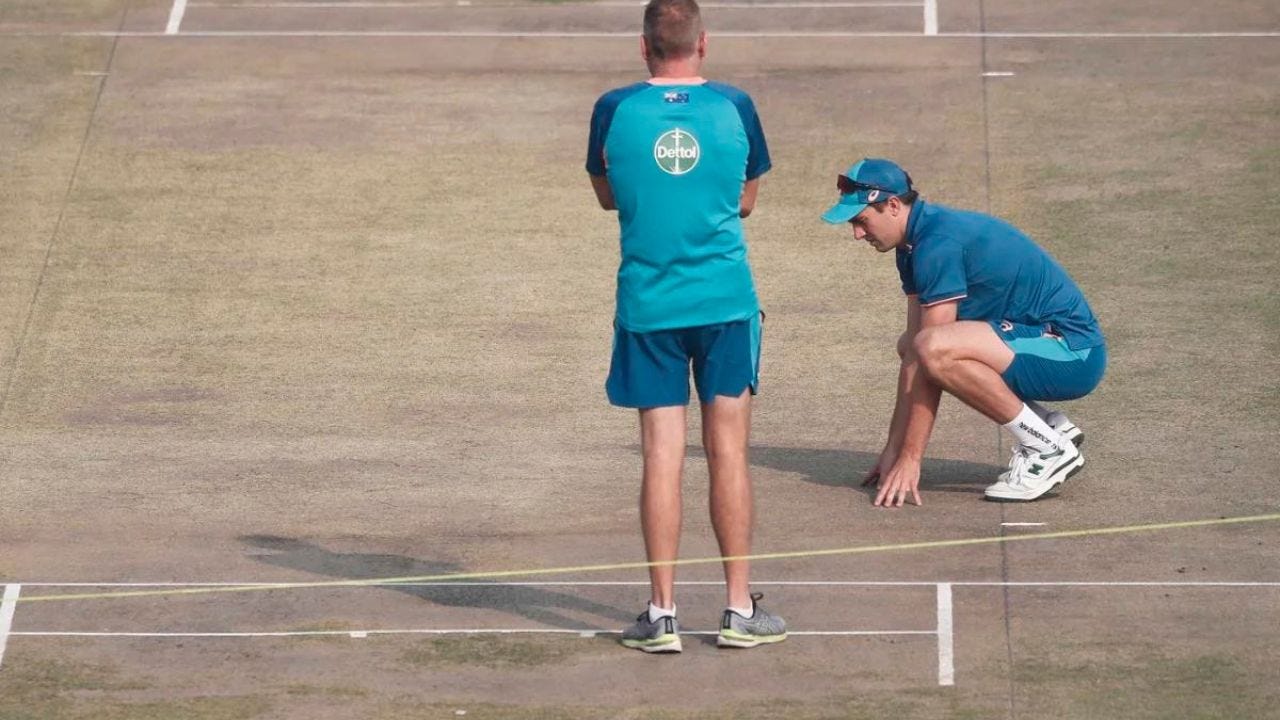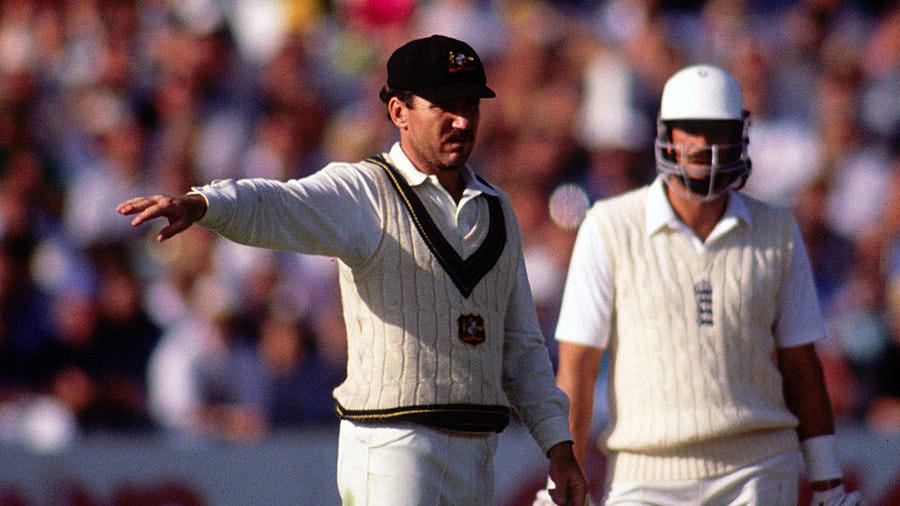TGIF...A Delhi pitch that resembles "scuffed linoleum in a suburban kitchen from the 1970s."
I don't want to bang on about this. But what exactly is "hard-nosed" cricket? And what is Allan Border looking for?
Border was recently portrayed by Fox Cricket as a shining light in an otherwise dark period of Australian cricket during the three-part documentary on the modest champion.
I don’t believe he’s wrong; he's just off the mark and perhaps swayed by his own personal agenda. After all, Border was forced to earn his stripes amongst a team that was barely competitive.
To be clear, here’s the quote:
"We’re giving blokes thumbs up when they beat us outside off stump. That’s just ridiculous. Don’t go stupid, but play Australian, hard-nosed cricket. Bloody hell."
The last sentence is pure 80s gold: "Bloody hell."
SpeakingNick is a reader-supported venture. Free and paid versions are available. The best way to support my writing is by taking out a paid subscription.
Anyways, it’s Friday. Thank God it’s Friday.
And the second Test starts this afternoon in Delhi.
Gideion Haigh, who’s on the ground, has described the surface as the, "DECK OF DUST." He and Pete Lalor have been joyfully recounting past pitch descriptions, such as "The green-eyed Gabba monster." "The deck of death." "Ladies, gentlemen, poms, welcome to the deck of death."—that was, of course, in Perth. Then there was "The Director's Cut"—my search engine brought up some abstract findings when I tried to locate this—Newtown Chilwell Cricket Club!

Nevertheless, too much pitch talk. OK, one more. My pitch analogy of the day goes to Gideon; he described the Delhi pitch as resembling "scuffed linoleum in a suburban kitchen from the 1970s." Picture that!
Next. I wanted to jump back to the intro.
What exactly is "hard-nosed" cricket? And what is Allan Border looking for?
Daniel Brettig, of The Age, wrote a great piece this week on the subject. Unfortunately, it has one of those "pesky walls" around it, so I’ll try to summarise for you here. If you do have an Age description, you should have no trouble locating it.
Daniel starts by stating the not-so-obvious:
Anytime Australia loses a Test match, a familiar undercurrent seeps through the national conversation. Somehow, at some level, the match wasn’t lost on skill, experience, preparation or execution.
So true—there is little introspection afforded, or appreciation for the level of talent of the opposition.
He continued with:
Instead it was forfeited because Australia’s cricketers were not “hard” enough, too accommodating, lacking passion and commitment.
And, then outlined the perverse form of patriotism shown and often demanded by an Australian sporting public.
It is as though, for many, the harder truths of Nagpur or any other sporting defeat are subsumed within a more jingoistic frame – Australian exceptionalism, where victories are won by fighting spirit, guts and determination, sledging and psyching out opponents.
That framing is encouraged by those who sold it to the public for years in past generations. First it was the Australian athletes who triumphed globally when this country bounced back more quickly than European nations wracked by the wages of the world wars. Then in the 1980s, ’90s and ’00s, younger men and women reaped the benefits of Australia’s sporting systems adopting better coaching, training or contracting methods before the rest caught up.
Right in the middle of that group was the Australian men’s cricket team led by Border, Mark Taylor, Steve Waugh and Ricky Ponting. Yes, they had a hard edge and were largely disliked around the world for unsociability with opponents. And yes, they glorified the baggy green cap.
He urged Australia to maintain its position on planning, and ethical decisions.
What Australia must do on this tour is hold the line in terms of the team’s planning. Changing things around after a bad initial experience tends to lead to further misadventure: just ask Ponting after his hellish 2001 trip to India, where a good ball first-up from Harbhajan Singh was followed by attempts to sweep, play from the crease and get down the pitch, all leading to further failures.
In summary: Brettig calls for Pat Cummins and co. to maintain their position. Resist the polemical views of the far right. Show the wider public that a more contemporary theme is sustainable, and can provide the same success, just in a different form. Maintain an even perspective—and lord forbid—try to enjoy what they are doing. Brettig asks for Australia to stay true to itself, and not fall back into, “the old tropes of an ugly Australia.” Delhi will be a key test of this resolve—agreed!
Thank you, Mr. Brettig.
A Friday finish…
From a selectorial viewpoint Australia seem to have backed themselves into a square corner. Normally they might have one decision to consider, but now it appears they have multiple issues that are all interconnected.
Below is a message I received from a reader earlier in the week. A cricket identity of some repute! No edits. Here you go…
Speaky - just read your article. My thoughts—the batting order needs a reshuffle and some changes—Renshaw, Handscomb, Carey and then all the bowlers is way too brittle.
I would break up Smith and Marnus. Smith at 5 or 6.
Head in for Renshaw obviously.
If Green is available I would consider opening with him to change the mix with a tall right hand opener. And, to hopefully push the game forward.
With our bowlers; Lyon and Murphy doesn’t work, and our batting from 8 down is poor. Cummins batting is a worry.
Starc and Agar in. Boland and Lyon out. We need a better bat at 8 and Lyon provides too much bounce on wickets where you don’t want bounce.
Last thing—get the selectors out of the change room. They are there to provide independent thinking not drink the same bath water—Fair point!
So his side is:
Khawaja, Warner (Green), Marnus, Head, Smith, Handscomb (Green), Carey, Agar, Starc, Cummins, Murphy
This goes to show that the Australian cricket public actually engages in strategic thinking around their team. Alas, it appears now, at the time of writing, that both Green and Starc will be unavailable!
Lastly, from the Indian side of the fence:
The Pitch: "Play the ball, not the pitch."
This was the tongue-in-cheek message from Ashwin and Rohit in response to the overplayed focus on the wicket in Nagpur. It should be said that it was directed more at the Australian media than at Pat Cummins’ dressing room, though it could also apply to the team. Of course it did.
Have a great weekend. Enjoy the cricket, both in India and New Zealand. We might get to the New Zealand vs. England series next week.
Thank you for being here.






